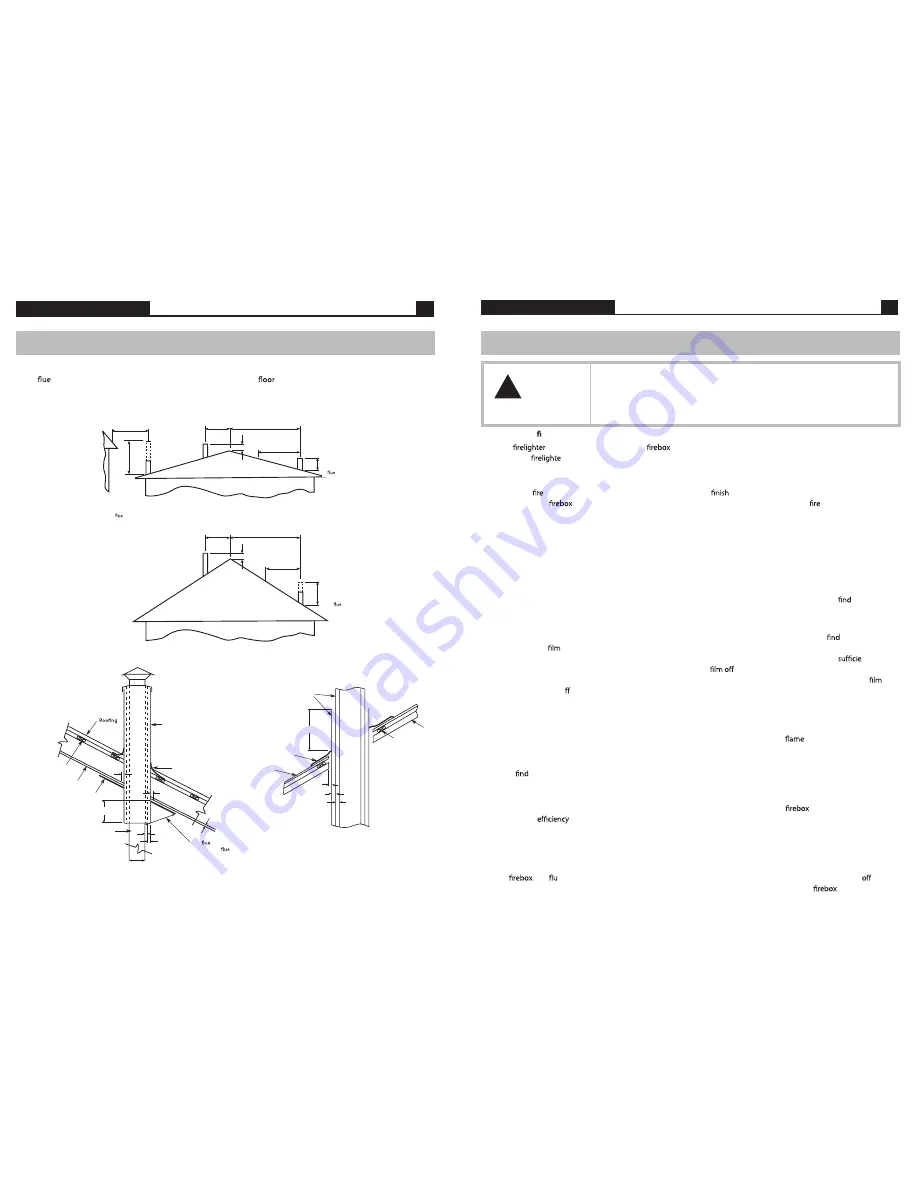
Kimberley Mk3 Freestanding
6
Kimberley Mk3 Freestanding
7
WARNING
!
DO NOT ATTEMPT TO OPERATE THIS APPLIANCE WITHOUT READING AND
UNDERSTANDING THESE OPERATING INSTRUCTIONS THOROUGHLY. FAILURE TO
OPERATE THIS APPLIANCE PROPERLY MAY CAUSE UNDUE DAMAGE TO THE
APPLIANCE OR RESULT IN A FLUE FIRE.
Read these instructions
Operating your Jindara woodheater
Starting your re
Place a
or paper in the bottom of the
and place a large amount of small kindling on top. Ignite the
paper or the
r. Set the air control to high and leave the main door open approximately 25mm. When the kindling
is burning, place about four pieces of small wood on top of the burning kindling. Once the wood is alight, close the main
door. After approximately 20 minutes, turn the air control down to medium and turn the fan on to Low speed.
On the initial
-up you may detect smoke coming from the paint
and from any oils that may be on the steel on
the outside of the
. This is normal. It is suggested to well ventilate your home on the initial
up. Please refer to
our section ‘Paint Curing and Care’.
The glass door
Always operate your heater with the door closed and locked. The only time you can leave the door open is on initial
lighting, or when reloading the heater.
Care of your glass
If you are burning good dry hardwood, you will have very little discolouration of your glass in a normal burning cycle.
If you aim for an overnight burn, you should not get much discolouration. You can control this by adjusting the air
control, moving from the left and slowly creeping the control to the right. After a number of days you will
the right
position to suit your requirements and the fuel that you are using.
Cleaning the glass
Generally the only time you will possibly need to clean your glass is after a long overnight burn. If you
that you have
a wet sticky black
on your glass (creosote), it is better to burn the heater as normal for one load of wood. When the
wood has burnt down to a hot bed of embers, open the door and leave it wide open until the glass cools
ntly to
be wiped with a damp cloth. This should clean all the white smoky
the glass. Creosote on the glass is normally a
sign that you have tried to get too long an overnight burn or you have burnt excessively wet or green wood. If the
on
the glass won’t come o with a wet cloth, you can use wet ash from the ash bed as a cleaner or commercial products
such as Crystal Clear, Johnson Foam Clean or Windex.
Normal Operations
When you get up in the morning, open up the air control of the heater to high position to start the embers glowing. Place
some wood on top of the embers and leave the door open 25mm. Once the fuel starts to
close the
door. As the heater starts to heat up turn the fan on to low, (approx 20 minutes) and begin reducing the air control
towards a lower setting.
You will
with the fan on low you will only need to run the heater between low and medium to maintain the
temperature you desire in your home. To obtain the maximum heat dissipation from the heater it is necessary to run the
fan at any time the heater is running above the low position.
For best results it is best to burn 300mm long wood and load your wood straight into the
front to rear. This will
give optimum
and recoverable heat, and minimise creosote formation and smoke emissions.
Overnight burn
Approximately 30 minutes before turning the heater down to overnight burn it is recommended to load the heater with
fuel for the overnight burn. Leave the air control in the medium to high position. Let the heater run for about thirty
minutes. This will reduce the moisture content in the fuel before shut down. (This will help reduce the creosote formation
in the
and e.) Set the air control to the setting you have found best for your requirements. Turn the fan and
retire. The aim when overnight burning is to have only a few hot embers left in the bottom of the
in the morning,
not huge lumps of wood.
3000mm
3000mm
3000mm
1000mm
min if clear
within
3000mm of
top
Increase from
1000mm min
until clear
within 3000mm
of
top
600mm min
More than 3000mm
600mm min
More than 3000mm
or less
3000mm
or less
Increase as
necessary
until
nothing
within
3000mm of
top
Any nearby
structure
3000mm
The
pipe shall extend not less than 4.6m above the top of the
protector. Note: Installation must be
carried out by a licensed installer in accordance with AS/NZS 2918:2001.
Flue pipe casing
Flashing
3 x
diameter
from active
to
heat sensitive
surface
Batten
Flue
pipe
Flashing
Flue pipe casings
Heat sensitive roof
25mm
25mm
25mm
Flue pipe
Gap 25mm
Gap 25mm
Batten
Ceiling
Ceiling Plate
See clause 4.6.3(b) of AS/NZS 2918:2001
25mm
12mm
25mm
150mm dia
Figure 5. Example of sloped ceiling penetration
Figure 6. Example of roof penetration
Rafter
See clause 4.8 of AS/NZS 2918:2001
Flue and chimney requirements
Installation
(continued)
























